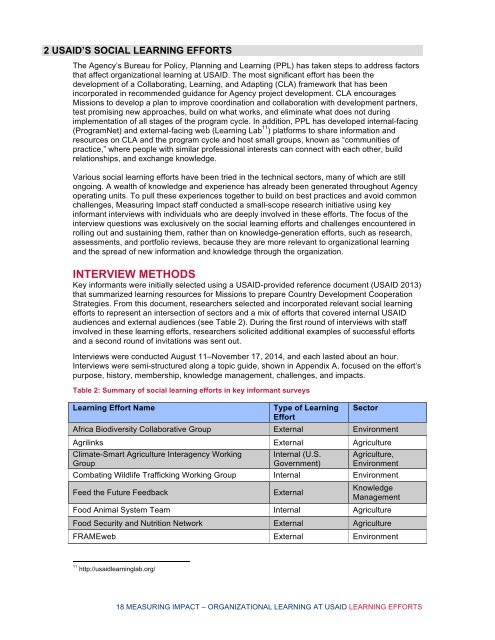MEASURING IMPACT Making Use of the Portfolio Organizational Learning at USAID
28Mzh2D
28Mzh2D
Create successful ePaper yourself
Turn your PDF publications into a flip-book with our unique Google optimized e-Paper software.
2 <strong>USAID</strong>’S SOCIAL LEARNING EFFORTS<br />
The Agency’s Bureau for Policy, Planning and <strong>Learning</strong> (PPL) has taken steps to address factors<br />
th<strong>at</strong> affect organiz<strong>at</strong>ional learning <strong>at</strong> <strong>USAID</strong>. The most significant effort has been <strong>the</strong><br />
development <strong>of</strong> a Collabor<strong>at</strong>ing, <strong>Learning</strong>, and Adapting (CLA) framework th<strong>at</strong> has been<br />
incorpor<strong>at</strong>ed in recommended guidance for Agency project development. CLA encourages<br />
Missions to develop a plan to improve coordin<strong>at</strong>ion and collabor<strong>at</strong>ion with development partners,<br />
test promising new approaches, build on wh<strong>at</strong> works, and elimin<strong>at</strong>e wh<strong>at</strong> does not during<br />
implement<strong>at</strong>ion <strong>of</strong> all stages <strong>of</strong> <strong>the</strong> program cycle. In addition, PPL has developed internal-facing<br />
(ProgramNet) and external-facing web (<strong>Learning</strong> Lab 11 ) pl<strong>at</strong>forms to share inform<strong>at</strong>ion and<br />
resources on CLA and <strong>the</strong> program cycle and host small groups, known as “communities <strong>of</strong><br />
practice,” where people with similar pr<strong>of</strong>essional interests can connect with each o<strong>the</strong>r, build<br />
rel<strong>at</strong>ionships, and exchange knowledge.<br />
Various social learning efforts have been tried in <strong>the</strong> technical sectors, many <strong>of</strong> which are still<br />
ongoing. A wealth <strong>of</strong> knowledge and experience has already been gener<strong>at</strong>ed throughout Agency<br />
oper<strong>at</strong>ing units. To pull <strong>the</strong>se experiences toge<strong>the</strong>r to build on best practices and avoid common<br />
challenges, Measuring Impact staff conducted a small-scope research initi<strong>at</strong>ive using key<br />
informant interviews with individuals who are deeply involved in <strong>the</strong>se efforts. The focus <strong>of</strong> <strong>the</strong><br />
interview questions was exclusively on <strong>the</strong> social learning efforts and challenges encountered in<br />
rolling out and sustaining <strong>the</strong>m, ra<strong>the</strong>r than on knowledge-gener<strong>at</strong>ion efforts, such as research,<br />
assessments, and portfolio reviews, because <strong>the</strong>y are more relevant to organiz<strong>at</strong>ional learning<br />
and <strong>the</strong> spread <strong>of</strong> new inform<strong>at</strong>ion and knowledge through <strong>the</strong> organiz<strong>at</strong>ion.<br />
INTERVIEW METHODS<br />
Key informants were initially selected using a <strong>USAID</strong>-provided reference document (<strong>USAID</strong> 2013)<br />
th<strong>at</strong> summarized learning resources for Missions to prepare Country Development Cooper<strong>at</strong>ion<br />
Str<strong>at</strong>egies. From this document, researchers selected and incorpor<strong>at</strong>ed relevant social learning<br />
efforts to represent an intersection <strong>of</strong> sectors and a mix <strong>of</strong> efforts th<strong>at</strong> covered internal <strong>USAID</strong><br />
audiences and external audiences (see Table 2). During <strong>the</strong> first round <strong>of</strong> interviews with staff<br />
involved in <strong>the</strong>se learning efforts, researchers solicited additional examples <strong>of</strong> successful efforts<br />
and a second round <strong>of</strong> invit<strong>at</strong>ions was sent out.<br />
Interviews were conducted August 11–November 17, 2014, and each lasted about an hour.<br />
Interviews were semi-structured along a topic guide, shown in Appendix A, focused on <strong>the</strong> effort’s<br />
purpose, history, membership, knowledge management, challenges, and impacts.<br />
Table 2: Summary <strong>of</strong> social learning efforts in key informant surveys<br />
<strong>Learning</strong> Effort Name<br />
Type <strong>of</strong><br />
Effort<br />
<strong>Learning</strong><br />
Sector<br />
Africa Biodiversity Collabor<strong>at</strong>ive Group External Environment<br />
Agrilinks External Agriculture<br />
Clim<strong>at</strong>e-Smart<br />
Group<br />
Agriculture Interagency Working<br />
Internal (U.S.<br />
Government)<br />
Agriculture,<br />
Environment<br />
Comb<strong>at</strong>ing Wildlife Trafficking Working Group Internal Environment<br />
Feed <strong>the</strong> Future Feedback<br />
External<br />
Knowledge<br />
Management<br />
Food Animal System Team Internal Agriculture<br />
Food Security and Nutrition Network External Agriculture<br />
FRAMEweb External Environment<br />
11<br />
http://usaidlearninglab.org/<br />
18 <strong>MEASURING</strong> <strong>IMPACT</strong> – ORGANIZATIONAL LEARNING AT <strong>USAID</strong> LEARNING EFFORTS


